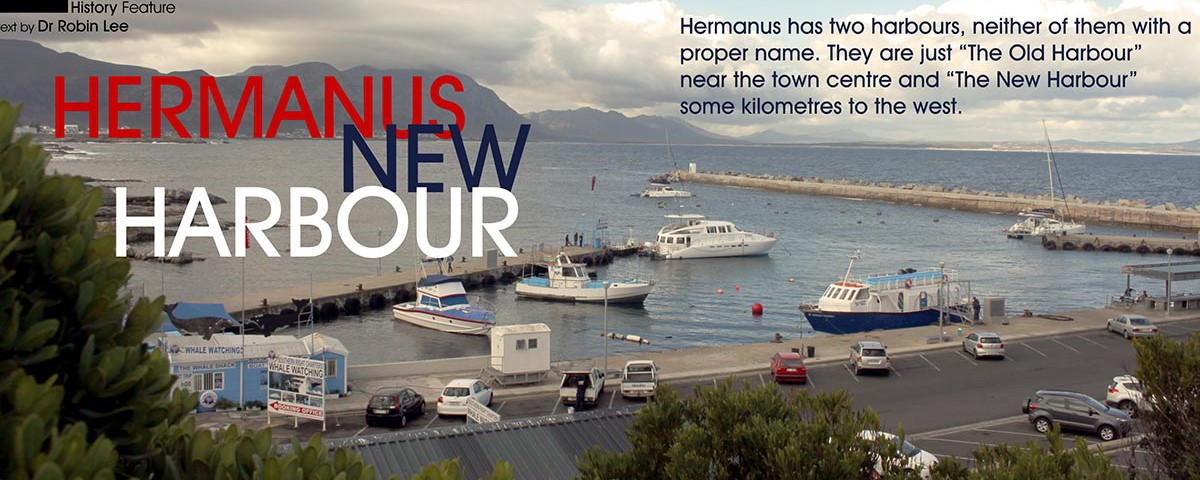Hermanus has two harbours, neither of them with a proper name. They are just “The Old Harbour” near the town centre and “The New Harbour” some kilometres to the west. The Old Harbour is very much better known than the New Harbour, as it has a Museum devoted to its maintenance and promotion, while the New Harbour is still officially a working ‘small fishing harbour’, to use the official description.
However, things may be changing for the New Harbour. Government funding is said to be in the pipeline to change several small harbours in which fishing is no longer taking place, into recreational and tourist attraction sites. This has been done with great success in several countries and, on the face of it, should be successful in Hermanus. One thing that is clear from a study of small harbour improvement abroad is that tourists and recreational users are appreciative of a history of the harbour in its working days. The Hermanus History Society is working on creating a history of our New Harbour.
The history is a whole lot more interesting than you might think from looking at the harbour in its present condition. Most residents probably only visit the site to patronise one or other of the two restaurants or to buy tickets for and board a boat for whale watching.
The New Harbour was first thought of in the late 1920s when it was becoming clear that the Old Harbour could not accommodate the number of fishing boats using it. In 1930 the Harbour Master, Mr. H R Hall was asked to prepare a report recommending a site for a larger harbour. He identified the present site as not perfect, but acceptable. At that time he referred to the little bay as a cove and called it “Still Bay”. Unfortunately he refers through his Report to ‘the new harbour’ and any chance of us having a nice ‘Still Bay Harbour’ was lost.
The Great Depression of the 1930s meant that there were no funds available to build the harbour. In 1939 a start appears to have been made, but World War II prevented the full construction until 1946. The southern breakwater (the present one) was finished first, as Hall recommended, but a second (east) breakwater was never built. This means that the harbour has always been rough water, and at intervals since 1959 the Town Council has appealed to central government to complete it. This has never been done and local newspapers have carried many reports of ships wrecked in the Harbour or washed out of the harbour and wrecked elsewhere. In a fishing boat named Dolphin was swept out of the harbour and eventually grounded on Grotto Beach. There are a distressing number of drownings recorded, especially off the breakwater.
In 1951 the harbour became operational. Most of the fishermen using the Old Harbour moved across. However, over-fishing by boats and trawlers from outside our area drastically reduced the catches of fish. In practical terms, the trawlers removed hundreds of tons of silver fish (called ‘doppies’ by the fishermen) which were the food source for larger fish which obviously then left the area.
In the 1950s and 1960s an alternative catch was found –perlemoen or abalone, as the rest of the world knows it. Young men arrived in town having heard that good money could be made by diving for abalone. In 1956 Brian McFarlane (senior) opened the first abalone processing factory and bought most of the harvest. Exports went mainly to the Far East.
Abalone was plentiful, for a while. Any diver could expect to harvest 1000 abalone of acceptable size in a day; 2000 was common; and the record was 6000. McFarlane paid 6 pence for each abalone so 2000 would equate to £50 in the currency of the time or more than a month’s wages for most of the young men.
We know a lot about these divers as they were well-educated men from European countries and they have left written records, many photographs and in one case a colour film. A few are still living in the area and I am in the process of interviewing each to get his story. Once again, unfortunately, over harvesting took place, abalone became very scarce, quotas were introduced and many legitimate fishers and divers were forced out of their occupations. Poaching became rampant and now the abalone are mainly to be found in the abalone farms that have been developed adjacent to the New Harbour.
The History Society is working with the Walker Bay Ski Boat Club, based in the Harbour, to gather the history of the period from 1960 to the present. If you have any information, photographs or other material please contact the writer at robinlee@hermanus.co.za and I will gladly meet with you.
Dr Robin Lee
Whale Talk

